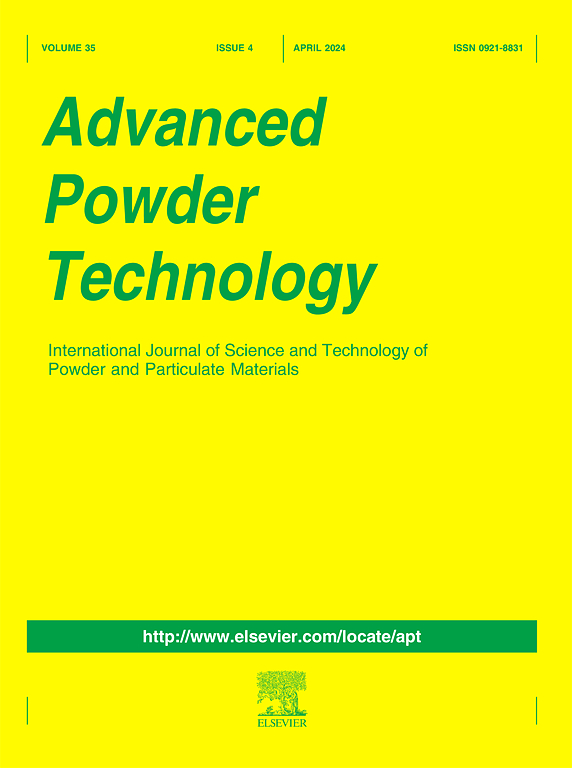Enhancing granular mixing performance in static mixer with wedge-block blending elements
IF 4.2
2区 工程技术
Q2 ENGINEERING, CHEMICAL
引用次数: 0
Abstract
The static mixer captures immense attention as an efficient, energy-saving and low-cost device for mixing grain particles, which plays a critical role in improving food nutrition, tastes and cooking styles. This study pursues better performance of static mixer, and adopted the discrete element method to establish a particle-blanking mixing model for mung beans and brown rice. A self-designed wedge-block continuous collision static mixer was compared with the Kenics and the Low Pressure Drop (LPD) static mixers, and a bench test was carried out to evaluate the particle mixing of the three mixers. The results manifest that, in terms of mixing efficiency, the average flow rates of Kenics, LPD and wedge-block static mixers were 0.33 kg/s, 0.22 kg/s and 0.43 kg/s in the simulation, compared to 0.35 kg/s, 0.27 kg/s and 0.51 kg/s in the bench test, respectively. As for mixing uniformity, the relative standard deviation (RSD) values for Kenics, LPD and wedge-block static mixers were 24.95 %, 21.87 % and 7.44 % in the simulation, and 30.34 %, 35.93 % and 9.64 % in the bench test, respectively. In summary, the proposed wedge-block static mixer, able to boost the mixing rate and quality, is an ideal choice for the continuous production of pellet mixing, thanks to its superior mixing performance than Kenics and LPD in mixing mung bean and brown rice. These findings lay an essential basis for optimizing granular static mixer in the future.

利用楔块混合元件增强静态混合器的颗粒混合性能
静态混合器作为一种高效、节能、低成本的谷物混合设备,在改善食物营养、口味和烹饪方式方面起着至关重要的作用,引起了人们的广泛关注。本研究为追求更好的静态混合器性能,采用离散元法建立了绿豆与糙米的颗粒落料混合模型。将自行设计的楔块连续碰撞静态混合器与Kenics静态混合器和低压降静态混合器进行了比较,并进行了台架试验,对三种混合器的颗粒混合效果进行了评价。结果表明:在混合效率方面,模拟的Kenics、LPD和楔块静态混合器的平均流速分别为0.33 kg/s、0.22 kg/s和0.43 kg/s,而台架试验的平均流速分别为0.35 kg/s、0.27 kg/s和0.51 kg/s。在混合均匀性方面,Kenics、LPD和楔块式静态混合器的相对标准偏差(RSD)在模拟中分别为24.95%、21.87%和7.44%,在台架试验中分别为30.34%、35.93%和9.64%。综上所述,所提出的楔块静态混合器在混合绿豆和糙米时的混合性能优于Kenics和LPD,能够提高混合速率和混合质量,是连续生产颗粒混合的理想选择。这些研究结果为今后优化颗粒静态混合器奠定了重要的基础。
本文章由计算机程序翻译,如有差异,请以英文原文为准。
求助全文
约1分钟内获得全文
求助全文
来源期刊

Advanced Powder Technology
工程技术-工程:化工
CiteScore
9.50
自引率
7.70%
发文量
424
审稿时长
55 days
期刊介绍:
The aim of Advanced Powder Technology is to meet the demand for an international journal that integrates all aspects of science and technology research on powder and particulate materials. The journal fulfills this purpose by publishing original research papers, rapid communications, reviews, and translated articles by prominent researchers worldwide.
The editorial work of Advanced Powder Technology, which was founded as the International Journal of the Society of Powder Technology, Japan, is now shared by distinguished board members, who operate in a unique framework designed to respond to the increasing global demand for articles on not only powder and particles, but also on various materials produced from them.
Advanced Powder Technology covers various areas, but a discussion of powder and particles is required in articles. Topics include: Production of powder and particulate materials in gases and liquids(nanoparticles, fine ceramics, pharmaceuticals, novel functional materials, etc.); Aerosol and colloidal processing; Powder and particle characterization; Dynamics and phenomena; Calculation and simulation (CFD, DEM, Monte Carlo method, population balance, etc.); Measurement and control of powder processes; Particle modification; Comminution; Powder handling and operations (storage, transport, granulation, separation, fluidization, etc.)
 求助内容:
求助内容: 应助结果提醒方式:
应助结果提醒方式:


